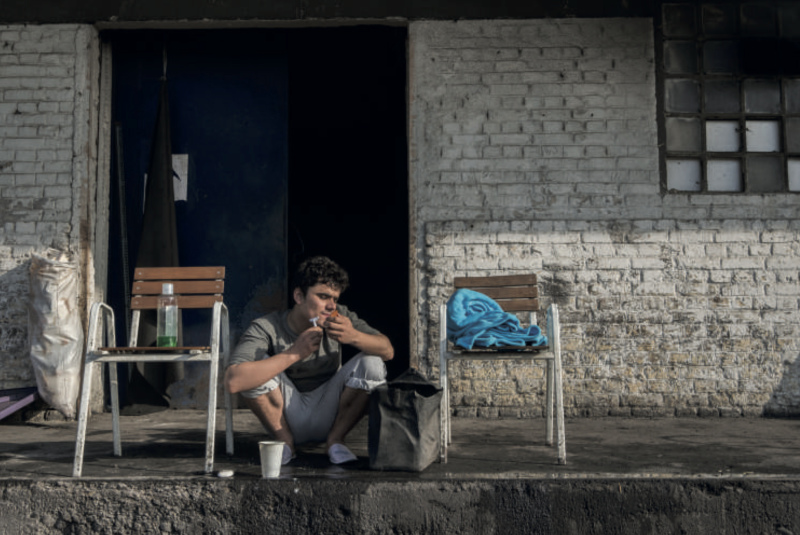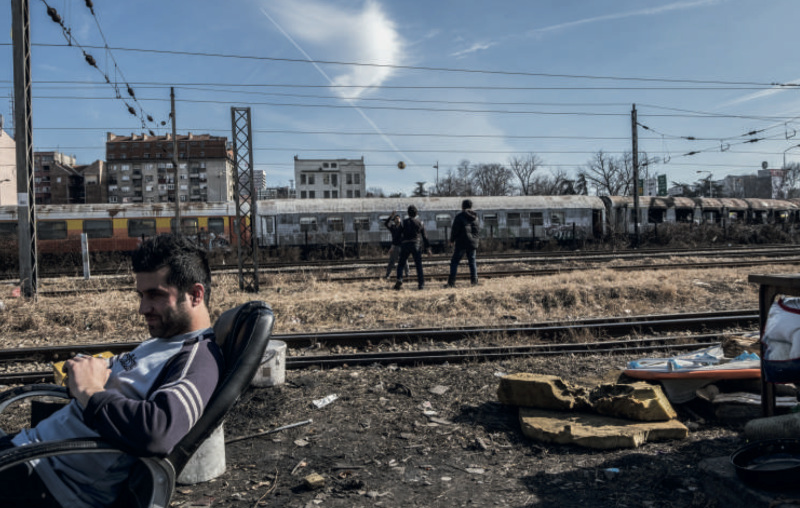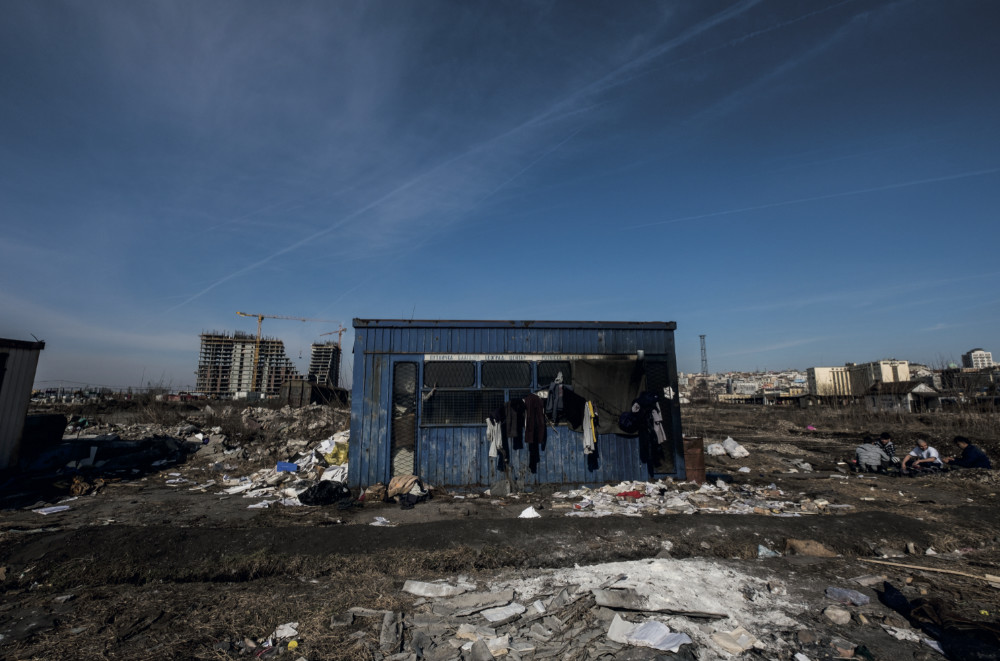In 2015, over 800,000 people, most of them fleeing Syria, crossed the Aegean Sea on makeshift boats, leaving the Turkish coastline for Greek islands, then continuing to continental Greece, and finally, via the Balkan route, to Western Europe. Faced with the scale of these arrivals, two kinds of public policy were devised: the unilateral closure of borders and an agreement with Turkey. Based on the study of Belgrade informal camp, this analysis highlights the pernicious effects of those policies: the marginalization of part of the migrants and the development of circumventions practices that forced migrants to take more risks.
In 2015 and 2016, the spillover of conflicts in the Middle East and Africa provoked forced displacements in numbers unprecedented since World War Two1. The ongoing conflict in Syria alone has led to the displacement of 11 million people: 6 million displaced internally, and 5 million, primarily towards countries neighboring Syria2. In 2015, over 800,000 people 3, most of them fleeing Syria, crossed the Aegean Sea on makeshift boats, leaving the Turkish coastline for Greek islands (including Chios, Kos and Lesbos), then continuing to continental Greece, and finally, via the Balkan route, to Western Europe.
Faced with the scale of these arrivals, two kinds of public policy were devised by the countries of the European Union and the Republic of Macedonia. Several countries located along the Balkan route, namely Hungary, Macedonia and Croatia, closed their borders unilaterally. There was also a global response by the EU, which signed an agreement with Turkey in March 2016 aimed at stopping the arrival of boats on the Greek islands.
European politicians and media characterize this situation as a “migration crisis” or a “migrant crisis”. This article analyzes how the lack of coordination in the migration policies of European states can be understood as a “reception crisis” in Europe4. The first section outlines how the containment and border-closure policies conducted by individual European states created a bottleneck in Greece and Serbia. The second section examines how European policies contribute to further marginalizing part of the migrant population, compelling it to remain “illegal”, despite the fact that the EU claims to fight smuggling networks and illegal practices that endanger the lives of displaced persons.
This article draws on fieldwork conducted between January and April 2017 along the full length of the Balkan route, in Greece and Serbia especially5.

European migration policies and the fragmentation of the balkans
The “Balkan route” refers to a migration route that links Turkey to Western Europe. In 2015, Hungary, Macedonia and Croatia unilaterally closed their borders, while in 2016 the EU signed an agreement with Turkey aimed at putting an end to migrant crossings of the Aegean Sea. These uncoordinated migration and containment policies led to an encampment situation in Greece and Serbia.
On June 17th, 2015, Viktor Orban, the Prime Minister of Hungary, issued a public statement declaring that he intended to erect a wall along the border between Hungary and Serbia, in order to put an end to the influx of migrants in his country. As early as November 2015, Croatia and Macedonia6 opted for a border-closure policy, and erected fences on their borders. In May 2015, the European Commissioner had proposed applying the “Hotspot Approach”, a measure that was designed to respond to “exceptional migratory flows”7. On the ground, this approach consists of setting up spaces, which sometimes take the shape of camps, where migrants are registered using their fingerprints, and where they face interviews with European and national migration services to determine whether they may be eligible for refugee status. They are then allowed to enter a member-state of the EU, or repatriated to their country of origin or to Turkey.
On March 18th, 2016, the EU and Turkey signed an agreement to put a stop to migrant crossings from the Turkish coast towards Europe. In exchange for Turkey acting as janitor of Europe’s borders, the agreement provided for European financial aid to Turkey to aid Syrians on its own territory; liberalizing visa rules for Turkish citizens; and reopening negotiations on Turkey’s accession to the EU8.
As soon as it came into force, the March 2016 Turkey-EU deal prompted a distinct fall in arrivals on the Greek islands —while not putting a full stop to them. From February 2016 to March 2016, when the deal kicked in, UNHCR registered a fall in arrivals on the Greek islands, from 57,066 to 3,650. In April 2017, this number had fallen to 1,1569. According to this agreement, the arrival of an “illegal” migrant on Greek territory must lead to their expulsion and replacement by a legal migrant registered in Turkey and wishing to enter Europe10 11. The agreement was termed “shameful” by several associative and activist networks, and prompted incomprehension from NGOs—but also from the members of the European Asylum Support Service, EASO. Even within Vial camp, the hotspot on the island of Chios12, one can read on a poster describing the process to request asylum: “Applicants for international protection must not be penalized due to their illegal entry or presence” , “The principle of non-refoulement must be ensured, even when a person does not apply for asylum ”. The poster bears the logos of EASO and Frontex (the EU Border and Coast Guard Agency).
The closure of the Hungarian, Croatian and Macedonian borders demonstrate the desire of these states to act solely on the migratory flows crossing their territory, at the expense of neighboring countries— Greece and Serbia. Hungary refuses to cooperate with its European neighbors and opposes extending the “hotspot approach” to its territory13.
This border-closure policy has also prompted the development of waiting zones and the establishment of informal camps in northern Greece, close to the Macedonian border, in particular at Idomeni, and in the North and West of Serbia, close to the borders with Hungary and Croatia, for instance at Sid and Sbotica. The establishment of official camps across Greece and Serbia, adding to the sharp decrease in arrivals in the wake of the Turkey-EU deal, led to the emptying-out of these informal encampments. Migrants were then sent, first towards Athens, then towards peripheral areas where reception centers were also opened14. For instance, the tourist village of Loytra in Thessaloniki (Greece) hosts almost 700 people. They are temporarily settled there by the government, pending a vast program to reorganize migrant reception centers15. In September 2017, in Greece, a considerable but varying number of centers sheltered over 45,000 people, while Serbia had 8,000 migrants shared over 18 centers on its territory16.
Thus, facing massive arrivals in 2014-2015, the policies of European states, and of the EU itself, succeeded only in establishing a containment policy. From a strictly statistical point of view, the Turkey-EU agreement met its goals by bringing sea traffic to Greece to a halt. Similarly, those countries that closed their borders broadly put a stop to migrant arrivals on their territory. But the EU, through its agreement with Turkey, chose to sub-contract management of the “problem” to its neighbor. And by closing their borders, Croatia, Hungary and Macedonia got rid of the problem by circumscribing it to Greece and Serbia. These short-sighted policies are responsible for the encampment situation in Greece and Serbia, and have led to an inextricable situation.

The marginalization of migrants and circumvention practices : Belgrade’s informal camp as case-study
Despite setting up official reception centers, existing EU policies resulted in perpetuating informal camps designed to circumvent the existing migratory system. The term “informal camp” is used here in opposition to “formal center,” and describes a settlement for migrants that is not managed by such official institutions as the UNHCR or governments.
First of all, as things stand, policies applied by the various institutions tasked with managing migrants favor refugees from Syria and Iraq, further marginalizing migrants from other regions. Moreover, the Dublin III17 agreement enables EU members to expel asylum seekers to the first country through which they entered Europe, which is generally Greece or Italy. Migrants are well aware of this situation and try to circumvent these barriers. “Non-official” camps are by-products of these strategies, as the case of Belgrade’s informal camp exemplifies.
In the center of Belgrade, an informal camp nearby the train station hosts around a thousand18 young men from Pakistan and Afghanistan, most of them under 30. They live inside old, disused warehouses that they call “barracks,” and a covered parking lot19. A few volunteer groups distribute meals and essentials, as well as logs to feed rustic wood-stoves. In the town center, not far from the camp, Médecins Sans Frontières runs a medical service.
The presence of these young men there might seem curious, since Serbia has 18 government-run reception and housing centers. In March 2017, such a center opened in the outskirts of Belgrade. But only a minority of people living in the “barracks” chose to move there, despite better facilities (hot showers, beds, a health system, and daily meals20), repeated exhortations from the town council, and easy access (a bus runs from the reception center directly to the train station). Fear of being expelled holds them back. This fear is based on rumors, and is, in principle, groundless—but it is deeply linked to their perception of European policies to manage migration. “Only those from Syria or Iraq are accepted in Europe”, an Afghan inhabitant of the Belgrade camp recounts, “I know that the situation is very bad in Syria, but it’s terrible in my country, too. I left after the Taliban attacked my village”21.
For the inhabitants of the Belgrade camp, entering a government reception center is seen as a major risk that could doom their migration project. Choosing to stay in the informal camp and to endure its dire conditions is a way to continue their journey by their own means. Everyone person I interviewed in the camp22 said they wished to continue their journey via Hungary or Croatia, despite those borders being closed. For those who wish to try the Hungarian route, the bus station nearby enables them to travel to the border town of Sbotica, in northern Serbia. I heard a young Pakistani getting off the bus in Sbotica jauntily announcing that this would be his seventh attempt to cross. His companion outbid him: “My ninth!” From Sbotica, migrants then head to the meeting-point set by the smuggler responsible for the crossing. They then try their luck by night, traveling in small groups of a single nationality. But the chances of success are very slim, and most of them return to Belgrade the next day, either to the “barracks” or, if they choose not to believe the rumors, to an official reception center. There, they wait for a more favorable occasion. Others stay in the surroundings of Sbotica, to try their luck again as soon as possible.
As Morgane Dujmovic and Pierre Sintès23 argue, Europe’s inability to overcome narrow national interests justifies characterizing the “migrant crisis” as a “crisis of EU migratory policy”24. Although the Turkey-EU did lead to a sharp decrease in the number of migrants reaching the Greek islands, the EU failed in implementing a coordinated migratory policy and sub-contracted the problem, while so of its member-states countries were adopting the same free-riding attitude at the expense of their neighbors. Finally, the example of the Belgrade camp and its Afghan and Pakistani residents show that the EU migratory policy is far from having fulfilled its stated aim of putting an end to smuggling networks, and that it forces migrants to develop ever-riskier circumvention practices.
Note 1: Despite ever-harder conditions for crossing, both of our two main interviewees in Belgrade, two young Afghan men, finally managed to reach the EU. After passing through Croatia, one of them submitted an asylum application in Switzerland, which was approved. The other, after having crossed the border between Serbia and Hungary, finally reached Paris, where he is seeking undocumented work. Note 2: In May 2017, the Belgrade town council finally gave orders to evacuate the informal camp at the train station, so as to enable the “barracks” to be destroyed as part of the Belgrade Waterfront development project.
Notes
- According to the United Nations High Commissioner for Refugees (UNHCR), the number of displaced persons in the world in 2016 was over 65 million: The equivalent of the population of France. ↩︎
- Turkey, with over three million Syrian on its territory according to Turkish government figures, is the top host country for Syrians, followed by Lebanon and Jordan. ↩︎
- According to The Refugee Crisis Through Statistics, a report published by the European Stability Initiative think-tank in February 2017, based on figures provided by Greek police, 876,200 people crossed the Turkish-Greek border in 2015, including 872,500 by sea. The report is online ↩︎
- Blanchard and Rodier, « « Crise migratoire » : ce que cachent les mots », Plein droit, vol. 111, no. 4, 2016. ↩︎
- This project was conducted jointly with Simone Peyronel, the author of a photo-reportage that is available here. ↩︎
- Pillant, Laurence. « En Grèce, une crise migratoire chronique », Plein droit, vol. 111, no. 4, 2016, pp. 31-34. ↩︎
- « L’approche des hotspots pour gérer des afflux migratoires exceptionnels », a European Commission document available online ↩︎
- « L’accord Turquie-Europe et ses implications : un partenariat incontournable mais sous conditions », analysis by the Robert SchumanFoundation, online ↩︎
- UNHCR figures ↩︎
- Interviews conducted in July-August 2016 and March 2017 ↩︎
- Press release following the signing of the Turkey-EU agreement of March 18th, 2016, online ↩︎
- In the case of Chios, this is also an “official” camp managed by the municipality and UNHCR. ↩︎
- Blanchard et Rodier, « « Crise migratoire » : ce que cachent les mots », Plein droit, vol. 111, no. 4, 2016. ↩︎
- Anastasiadou, Marvakis, Mezidou, Speer, « From transit hub to dead end : A chronicle of Idomeni », report by borderingeurope, 2017 ↩︎
- March 2016 fieldwork and interviews ↩︎
- UNHCR factsheet, September 2017, online ↩︎
- The Dublin Regulation determines which EU member state is responsible for processing a request for asylum. According to the Dublin principle, the member state responsible for processing an asylum request is the one that played the greatest role in the migrant’s entry onto EU territory. In practice, this is either the first country of entry (in the vast majority of cases, Greece or Italy,) or the country that granted a visa. ↩︎
- A March 2017 estimate by organisations working in the camp. ↩︎
- See Simone Peyronel’s photo-reportage available on this site. ↩︎
- As observed in March 2017. ↩︎
- Interview with an inhabitant of the Belgrade informal camp, March 2017. ↩︎
- Interviews, February and March 2017. ↩︎
- Morgane Dujmovic et Pierre Sintès, « Chauvinisme frontalier sur la « route des Balkans » », Hommes et migrations, 2017. ↩︎
- Idem ↩︎

